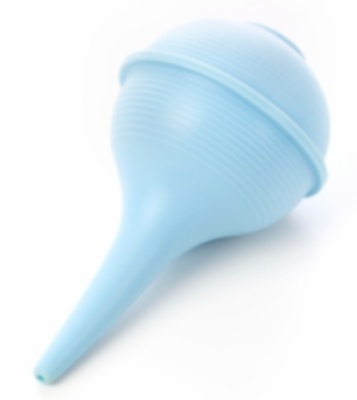Saline Sinus Rinse Recipe
 Saline sinus rinses can bring relief to patients with chronic sinus or rhinitis problems without the use of medication.
Saline sinus rinses can bring relief to patients with chronic sinus or rhinitis problems without the use of medication.
If you suffer from chronic or acute sinus infections, sinus rinses can be helpful in removing and thinning out excessive mucus. If you have allergic rhinitis, these rinses can bring relief by removing allergens from the nostrils and sinuses.
Although easy to use, the rinsing process may seem unusual at first and may take a little getting used to.
Several commercial sinus rinse devices are available without a prescription. They are convenient to use and can be found in most pharmacies. But you can also make your own rinse at home with only three ingredients and at a fraction of the cost.
Saline Rinse Recipe
Ingredients
1. Pickling or canning salt-containing no iodide, anti-caking agents or preservatives (these can be irritating to the nasal lining)
2. Baking soda
3. 8 ounces (1 cup) of lukewarm distilled or boiled water
In a clean container, mix 3 teaspoons of iodide-free salt with 1 teaspoon of baking soda and store in a small airtight container. Add 1 teaspoon of the mixture to 8 ounces (1 cup) of lukewarm distilled or boiled water.
Use less dry ingredients to make a weaker solution if burning or stinging is experienced. For children, use a half-teaspoon with 4 ounces of water.
Using a soft rubber ear bulb syringe, infant nasal bulb or a commercial nasal saline rinse product from your drug store, use the rinse by following these steps:
1. Draw up saline into the bulb. Tilt your head downward over a sink (or in the shower) and rotate to the left. Squeeze approximately 4 ounces of solution gently into the right (top) nostril. Breathe normally through your mouth. In a few seconds the solution should come out through your left nostril. Rotate your head and repeat the process on the left side.
2. Adjust your head position as needed so the solution does not go down the back of your throat or into your ears.
3. Blow your nose very gently to prevent the solution from going into your ear and causing discomfort.
4. After using the rinse, you may continue using your prescribed nasal medications as normal. You may notice that they work better.
Do not use sinus rinses if your nasal passageway is severely blocked. As with any medical product, be sure to speak to your doctor about using sinus rinses and stop using if you experience pain, nosebleeds or other problems.
An allergist / immunologist has specialized training and experience to accurately diagnose your condition and provide a treatment plan to help you feel better.
Find out more information about rhinitis or seasonal allergic rhinitis (hay fever).
Find out more information about sinusitis (rhinosinusitis).
The AAAAI's Find an Allergist / Immunologist service is a trusted resource to help you find a specialist close to home.
1/10/2024